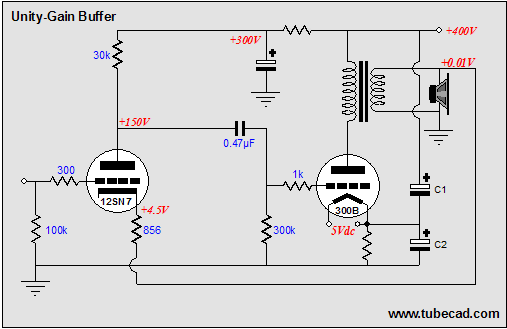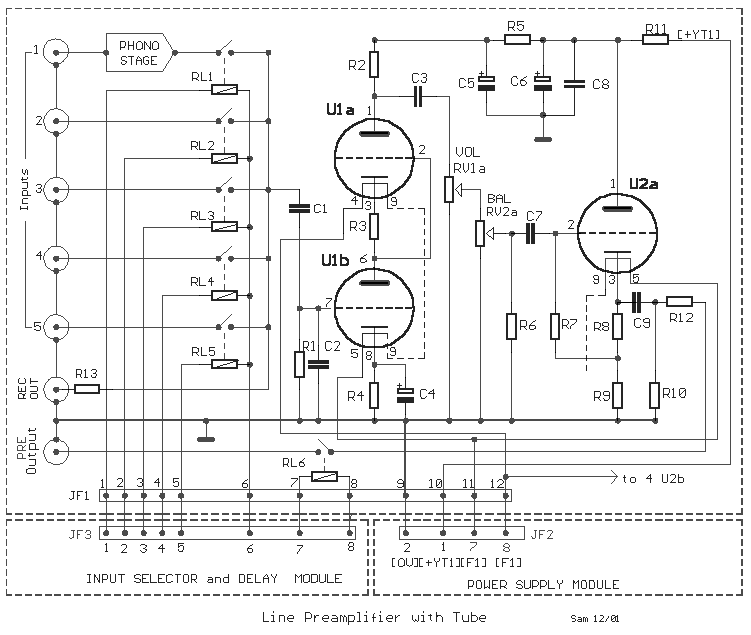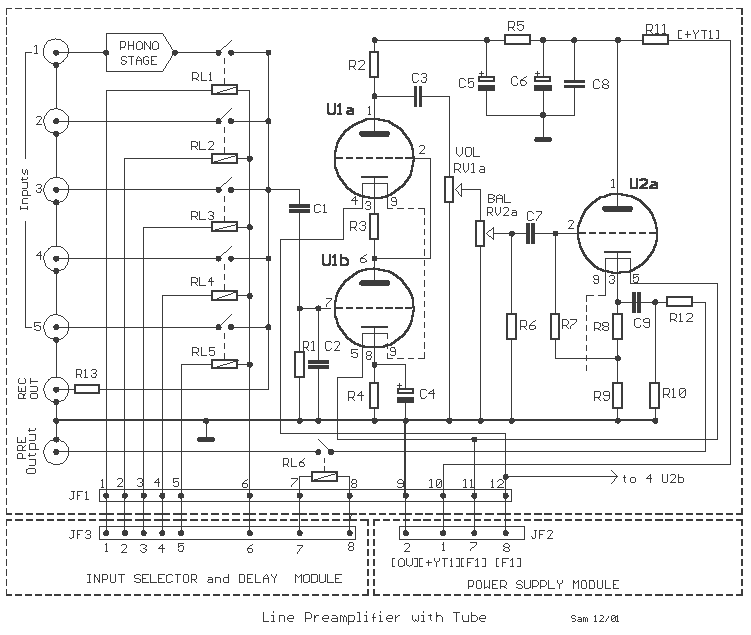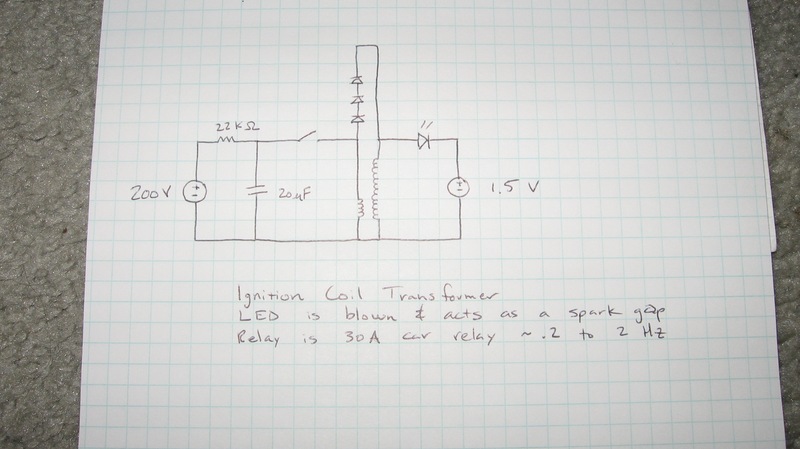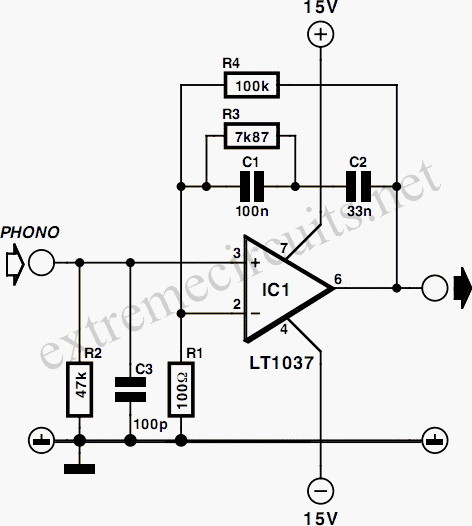
Vacuum Tube Preamp
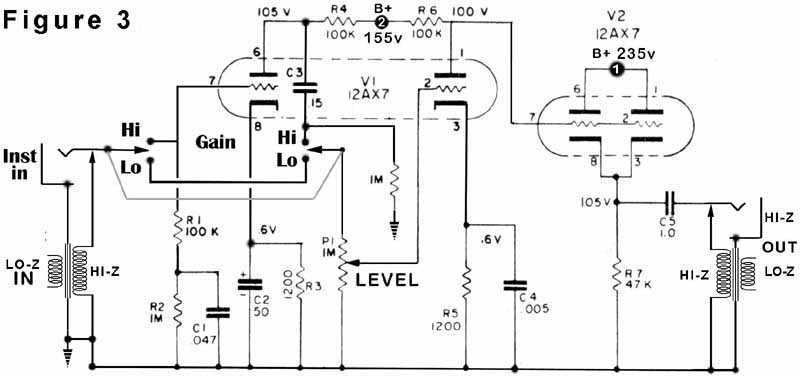
Figure 1 shows distortion variations in red and violet. Notice how the violet wave follows the green wave perfectly during its positive excursion but falls short of the mark during the negative swing. The red wave is more symmetrical, but does not "clip" like an overdriven IC op-amp. This is what I like to call "The Sonic Airbag," or Electric Crayon effect. Op-amps are linear-clean right up until the point of clipping; some discrete transistor and vacuum tube designs have a non-linear window between clean and clipped.
The described circuit illustrates the behavior of distortion in audio signals, particularly focusing on the characteristics of operational amplifiers (op-amps) and their clipping behavior. The violet waveform demonstrates a tracking accuracy with the green reference signal during the positive half-cycle, indicating a well-functioning op-amp under normal conditions. However, during the negative half-cycle, the violet waveform exhibits a shortfall, suggesting that the op-amp enters a non-linear region, leading to distortion.
The red waveform, in contrast, presents a more symmetrical shape, which indicates that it maintains a more consistent output without the abrupt clipping that often occurs in overdriven op-amps. This behavior can be attributed to the design of the circuit, which may employ feedback mechanisms or other components that help manage distortion levels.
The term "Sonic Airbag" or "Electric Crayon effect" refers to a specific auditory characteristic where the sound remains pleasant and cohesive, even when distortion occurs. This phenomenon can be particularly desirable in audio applications, as it allows for a certain degree of signal manipulation without sacrificing overall sound quality.
In the context of audio engineering, it is critical to understand the linear versus non-linear behavior of different amplification technologies. While op-amps provide a clean amplification up to the clipping point, discrete transistor and vacuum tube designs often exhibit a more gradual transition into distortion. This non-linear response can create a warmer, more musical sound, which is sometimes preferred in certain audio applications.
In summary, the circuit's analysis highlights the importance of understanding waveform behavior in relation to distortion, emphasizing the differences between linear op-amp performance and the more nuanced characteristics found in discrete and tube amplifiers. This knowledge is vital for engineers and designers seeking to achieve desired sonic qualities in their audio systems.Figure 1 shows distortion variations in red and violet. Notice how the violet wave follows the green wave perfectly during its positive excursion but falls short of the mark during the negative swing. The red wave is more symmetrical, but does not "clip" like an overdriven IC op-amp. This is what I like to call "The Sonic Airbag," or Electric Crayon effect. Op-amps are linear-clean right up until the point of clipping, some discrete transistor and vacuum tube designs have a non-linear window between clean and clipped.
🔗 External reference
The described circuit illustrates the behavior of distortion in audio signals, particularly focusing on the characteristics of operational amplifiers (op-amps) and their clipping behavior. The violet waveform demonstrates a tracking accuracy with the green reference signal during the positive half-cycle, indicating a well-functioning op-amp under normal conditions. However, during the negative half-cycle, the violet waveform exhibits a shortfall, suggesting that the op-amp enters a non-linear region, leading to distortion.
The red waveform, in contrast, presents a more symmetrical shape, which indicates that it maintains a more consistent output without the abrupt clipping that often occurs in overdriven op-amps. This behavior can be attributed to the design of the circuit, which may employ feedback mechanisms or other components that help manage distortion levels.
The term "Sonic Airbag" or "Electric Crayon effect" refers to a specific auditory characteristic where the sound remains pleasant and cohesive, even when distortion occurs. This phenomenon can be particularly desirable in audio applications, as it allows for a certain degree of signal manipulation without sacrificing overall sound quality.
In the context of audio engineering, it is critical to understand the linear versus non-linear behavior of different amplification technologies. While op-amps provide a clean amplification up to the clipping point, discrete transistor and vacuum tube designs often exhibit a more gradual transition into distortion. This non-linear response can create a warmer, more musical sound, which is sometimes preferred in certain audio applications.
In summary, the circuit's analysis highlights the importance of understanding waveform behavior in relation to distortion, emphasizing the differences between linear op-amp performance and the more nuanced characteristics found in discrete and tube amplifiers. This knowledge is vital for engineers and designers seeking to achieve desired sonic qualities in their audio systems.Figure 1 shows distortion variations in red and violet. Notice how the violet wave follows the green wave perfectly during its positive excursion but falls short of the mark during the negative swing. The red wave is more symmetrical, but does not "clip" like an overdriven IC op-amp. This is what I like to call "The Sonic Airbag," or Electric Crayon effect. Op-amps are linear-clean right up until the point of clipping, some discrete transistor and vacuum tube designs have a non-linear window between clean and clipped.
🔗 External reference
